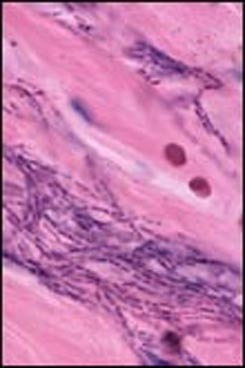
Anthrax is an acute infectious disease caused by a spore-forming bacterium called Bacillus anthracis.
Anthrax is generally acquired following contact with anthrax-infected animals or anthrax-contaminated animal products. Anthrax has received heightened attention recently because of its use as a biological warfare agent.
What is Bacillus anthracis?
- Bacillus anthracis, the etiologic agent of anthrax, is a large, gram-positive, non-motile, spore-forming bacterial rod. The three virulence factors of Bacillus anthracis are edema toxin, lethal toxin, and a capsular antigen. Human anthrax has three major clinical forms: cutaneous, inhalation, and gastrointestinal.
- Bacillus anthracis spores do not have a characteristic appearance such as color, smell, or taste. Spores themselves are too small to be seen by the naked eye, but have been mixed with powder to transport them.
What are the incidence rates of anthrax?
As of December 5, 2001, a total of 22 cases of anthrax have been identified in the United States -- 11 were confirmed as inhalational anthrax and 11 (seven confirmed and four suspected) were cutaneous. Of the 11 cases of inhalational anthrax, direct exposure to Bacillus anthracis-containing envelopes was confirmed or likely in the first nine cases.
Before 2001, the incidence rates of anthrax were:
- From January 1955 to December 1999, there were 236 reported cases of anthrax, most of them cutaneous, in 30 states and the District of Columbia.
- The last case of inhalational anthrax in the United States, before 2001, was in 1976 in California. A home craftsman died of the disease. He was exposed through his work with yarn; Bacillus anthracis was isolated from some of the imported yarns used by the patient.
- The last case of cutaneous anthrax, before 2001, occurred in North Dakota, in 2000. It was the only case since 1992.
The case fatality rates for the various forms of anthrax are:
- Cutaneous: Early treatment of cutaneous anthrax is usually curative, and early treatment of all forms is important for recovery. Patients with cutaneous anthrax have reported case fatality rates of 20 percent without antibiotic treatment and less than 1 percent with it.
- Inhalational: Although case-fatality estimates for inhalational anthrax are based on incomplete information, the rate is extremely high, approximately 75 percent, even with all possible supportive care including appropriate antibiotics. Estimates of the impact of the delay in post-exposure prophylaxis or treatment on survival are not known.
- Gastrointestinal: For gastrointestinal anthrax, the case-fatality rate is estimated to be 25 percent to 60 percent. The effect of early antibiotic treatment on the case-fatality rate is not defined.
 Print
Print Email
Email







